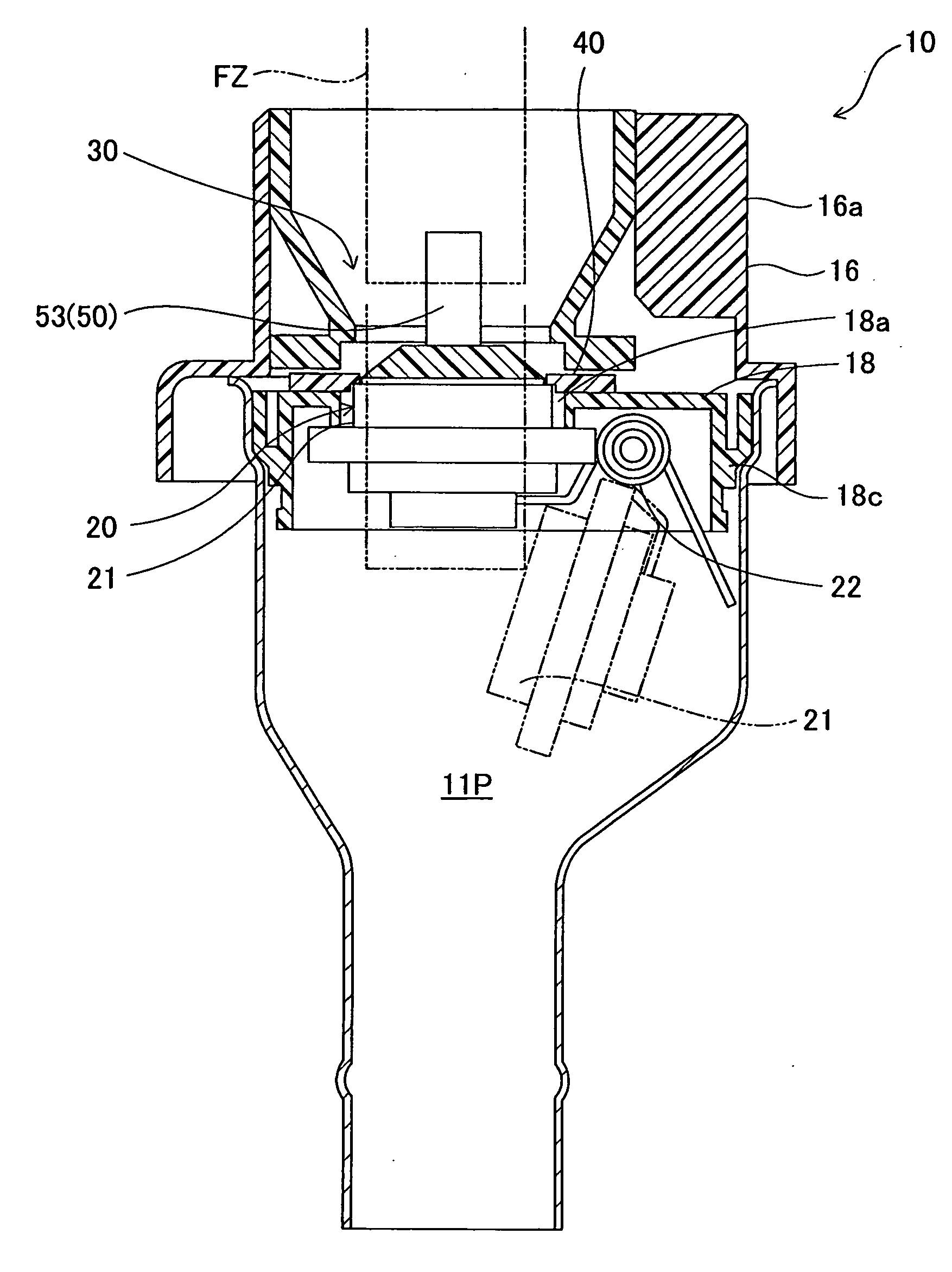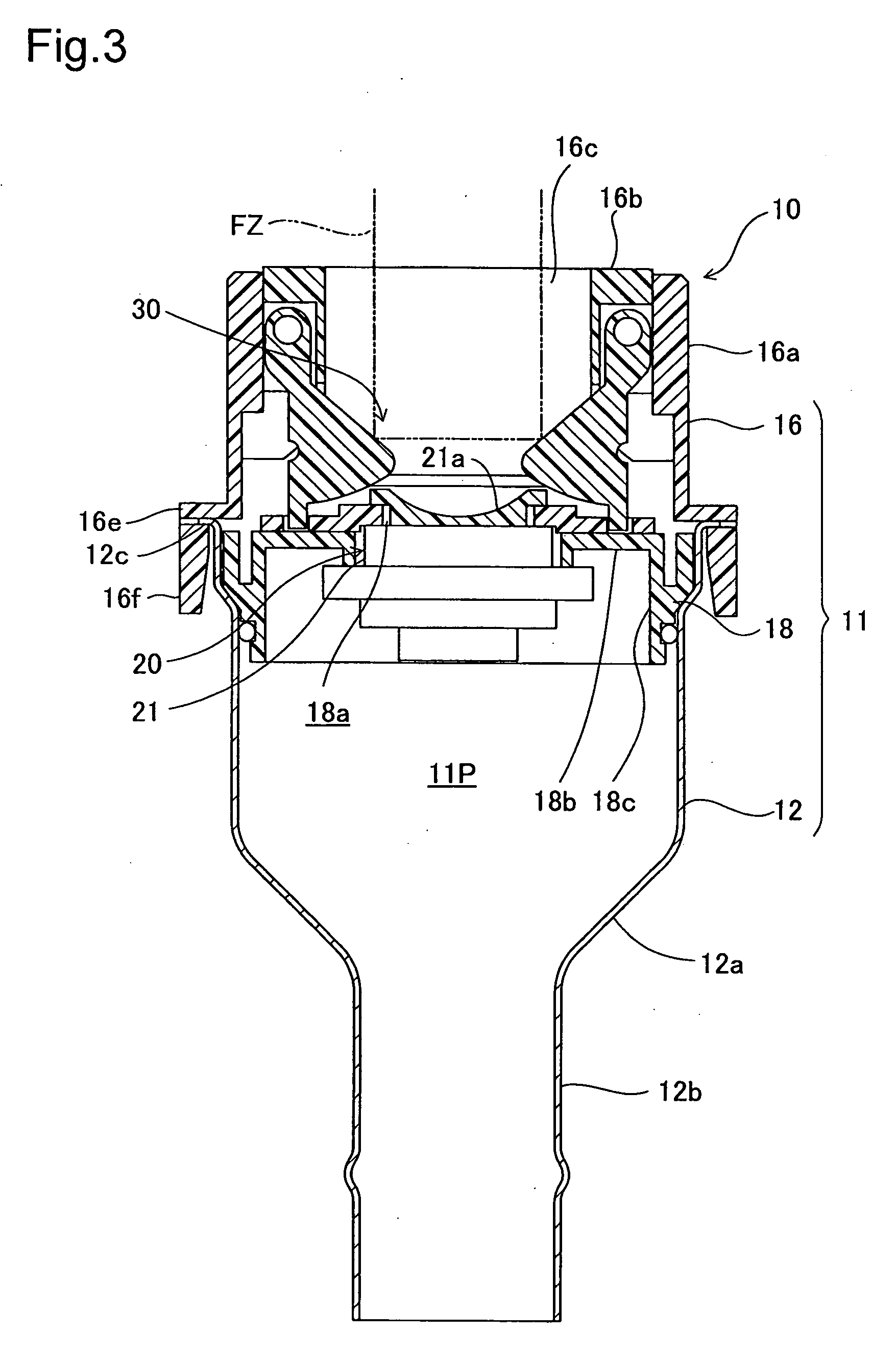Fuel tank opening-closing device
a technology for opening and closing the fuel tank, which is applied in the direction of liquid handling, packaging goods, transportation and packaging, etc., can solve the problems of reducing the sealing function or degrading the risk of the flapper valve, and achieve the effect of facilitating discharge and easing the distance of the gap
- Summary
- Abstract
- Description
- Claims
- Application Information
AI Technical Summary
Benefits of technology
Problems solved by technology
Method used
Image
Examples
first embodiment
A. First Embodiment
[0050](1) General Configuration of Fuel Tank Closure System
[0051]FIG. 1 is a perspective view depicting a rear section of an automobile equipped with a diesel engine according a first embodiment of the present invention, shown with the fuel cover open. A fuel cover FL for supplying a fuel (diesel) is reclosably supported at the rear section of the body of the automobile. The fuel cover FL has a cover body FLa conforming to the contours of the exterior panels of the vehicle and reclosably supported on a vehicle exterior panel via a hinge FLb. The space revealed by the opened fuel cover FL functions as a fueling bay FR, and a fuel tank opening-closing device 10 supported on a base plate BP has been arranged inside the fueling bay FR. The fuel tank opening-closing device 10 is a mechanism whereby fuel can be supplied from a fueling nozzle without using a fuel cap, and has been designed so that once the fuel cover FL has been opened, fuel can be supplied from a fuelin...
second embodiment
B. Second Embodiment
[0080]FIG. 10 is an exploded perspective view showing a fuel tank opening-closing device 10B according to a second embodiment. A feature of the present embodiment is the arrangement of a nozzle detection mechanism 50B for detecting insertion of a fueling nozzle. Specifically, a nozzle detection member 51B of this nozzle detection mechanism 50B includes introductory push parts 53B disposed to both sides of the fuel passage 11P; resilient support pieces 56B linked at one end thereof to the introductory push parts 53B so as to extend upward therefrom; and a fastened linking arm 57B that links the resilient support pieces 56B in their upper portion. The fastened linking arm 57B is a band-shaped member of semicircular form fastened to the opening-defining member. With this arrangement, when the introductory push parts 53B, 53B are pushed towards the perpendicular direction with respect to the direction of insertion of the fueling nozzle FZ, spring force is generated c...
third embodiment
C. Third Embodiment
[0081]FIG. 11 is a sectional view showing a fuel tank opening-closing device 10C according to a third embodiment. A feature of the present embodiment is the arrangement of a locking mechanism 60C adapted to operate in interlocked fashion in association with insertion of the fueling nozzle FZ. Specifically, locking members 61C of the locking mechanism 60 have been integrally formed with introductory push parts 53C and are designed to shuttle between a locked position at which the locking members 61C are engaged by locked parts 62C of an opening-closing member 21C, and an unlocked position at which through pushing of the introductory push parts 53C the locking members 61C have disengaged from the locked parts 62C so that the opening operation of the opening-closing member 21C becomes possible. Thus, an arrangement whereby the locking members 61C of the locking mechanism 60 shuttle between the locked position and the unlocked position with respect to the opening-clos...
PUM
| Property | Measurement | Unit |
|---|---|---|
| diameter | aaaaa | aaaaa |
| diameter | aaaaa | aaaaa |
| diameter | aaaaa | aaaaa |
Abstract
Description
Claims
Application Information
 Login to View More
Login to View More - R&D
- Intellectual Property
- Life Sciences
- Materials
- Tech Scout
- Unparalleled Data Quality
- Higher Quality Content
- 60% Fewer Hallucinations
Browse by: Latest US Patents, China's latest patents, Technical Efficacy Thesaurus, Application Domain, Technology Topic, Popular Technical Reports.
© 2025 PatSnap. All rights reserved.Legal|Privacy policy|Modern Slavery Act Transparency Statement|Sitemap|About US| Contact US: help@patsnap.com



